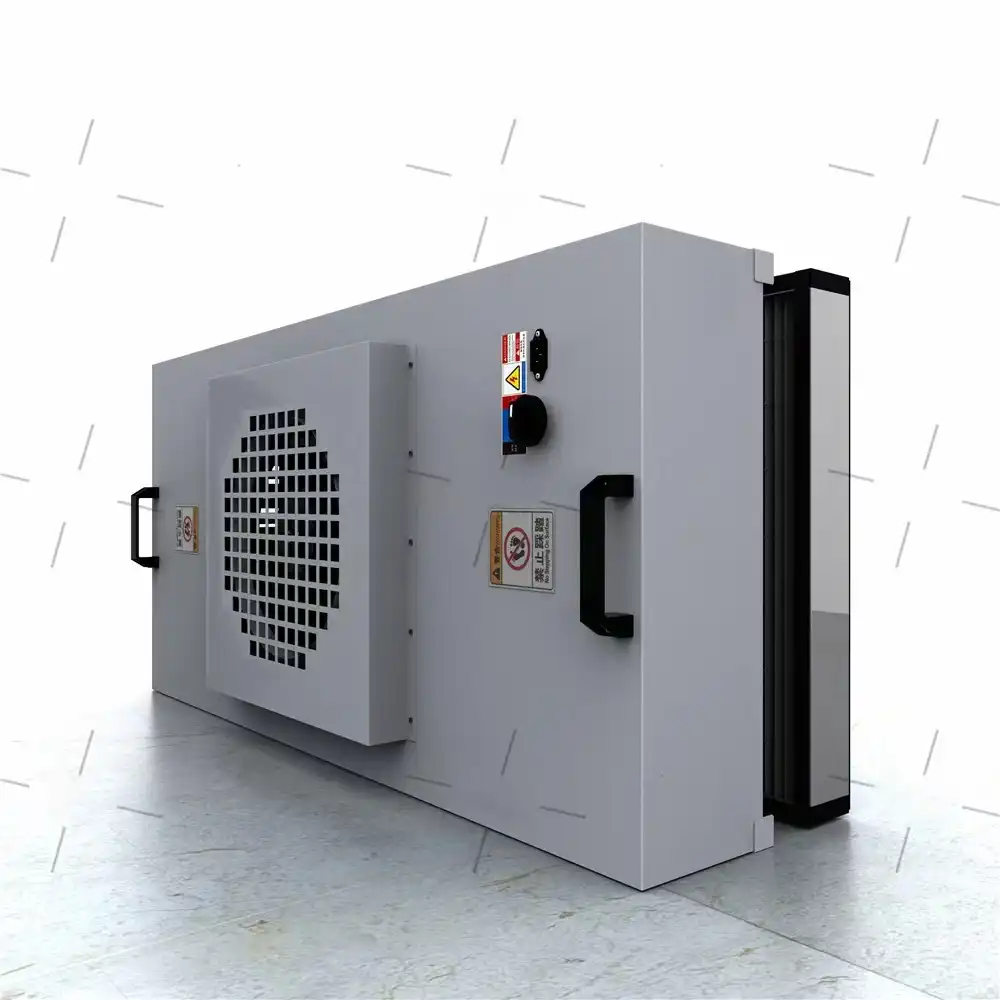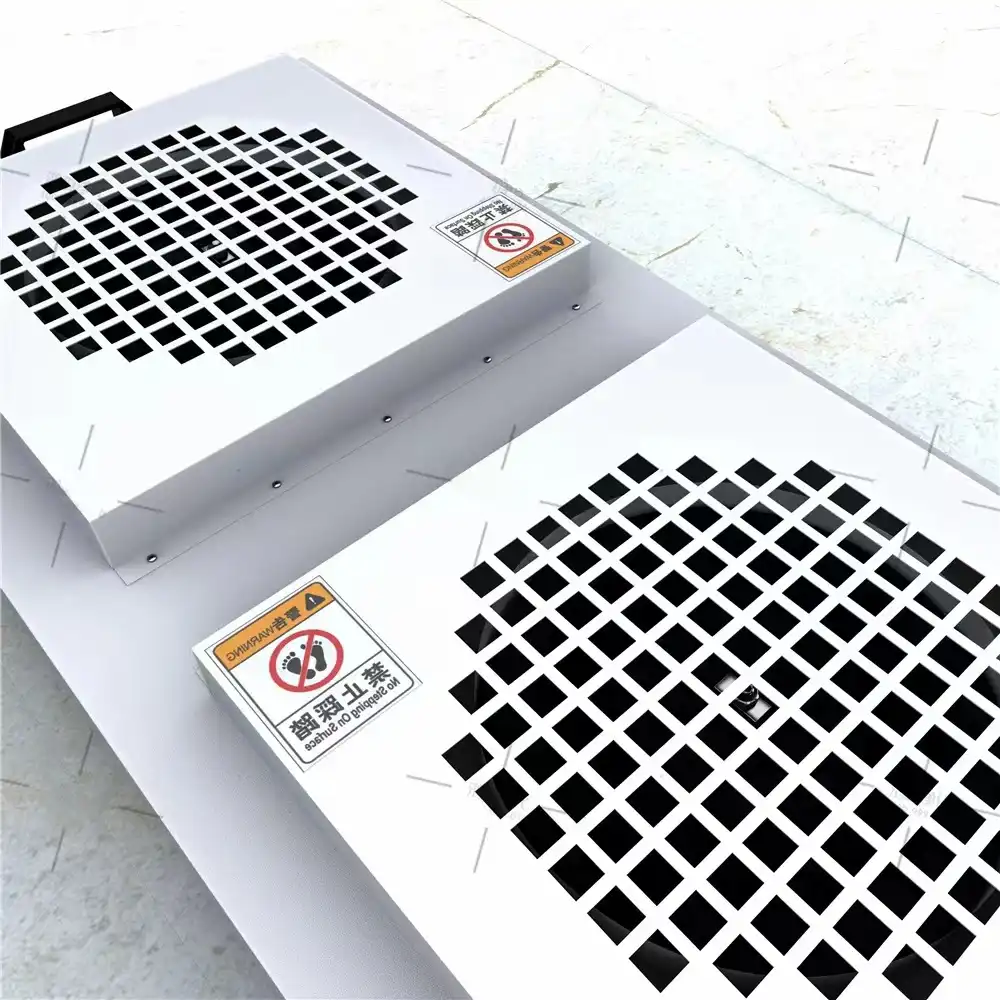
How do you maintain an FFU?
2025-04-16 17:09:06
Proper maintenance of FFU (Fan Filter Unit) systems is essential for ensuring clean, contamination-free environments in laboratory settings. Regular upkeep of these crucial air filtration systems not only extends their operational lifespan but also guarantees consistent performance in maintaining air purity standards. This comprehensive guide will explore the best practices for FFU maintenance, helping laboratory professionals preserve their investment while ensuring optimal working conditions.

The maintenance of an FFU Fan Filter Unit requires a systematic approach that includes regular inspection, filter replacement, motor maintenance, and performance monitoring. Typically, a comprehensive maintenance schedule involves weekly visual inspections for any visible damage or unusual noise, monthly cleaning of external surfaces, quarterly inspection of filter media for clogging or damage, and semi-annual comprehensive performance testing. The key components that require focused attention include the HEPA or ULPA filters (which may need replacement every 1-3 years depending on usage), fan motors (requiring lubrication and electrical checks), and control systems. By following a structured maintenance protocol, laboratories can ensure their FFU systems maintain peak efficiency, extend service life beyond the typical 60,000 hours, and provide consistent air quality performance that meets stringent cleanliness standards.
Essential FFU Maintenance Procedures
Regular Inspection and Cleaning Protocols
Maintaining a rigorous inspection and cleaning schedule is fundamental to the longevity and efficiency of your FFU Fan Filter Unit. These sophisticated air purification systems require methodical attention to ensure optimal performance. Begin with weekly visual inspections, checking for any physical damage to the housing, unusual vibrations, or unexpected noise during operation. Pay particular attention to the exterior surfaces, which can accumulate dust and particulates that might eventually impact performance.
The cleaning process should be executed with precision – first, always disconnect the power supply to prevent any electrical hazards. Use non-abrasive, non-corrosive cleaning agents specifically formulated for laboratory equipment. Microfiber cloths are preferable for wiping exterior surfaces, as they minimize the risk of scratching while effectively capturing dust particles. For more intensive cleaning operations that may involve partial disassembly, consult the manufacturer's guidelines or engage certified technicians.
When it comes to maintaining clean and sterile environments in laboratories, the FFU Fan Filter Unit is an essential piece of equipment. Designed to ensure optimal air quality, these units are used in a variety of applications where contamination control is crucial. Whether you're in the fields of scientific research, biotechnology, or quality control, FFUs provide a cost-effective solution to maintain the cleanliness of your workspace. A Fan Filter Unit (FFU) is a self-contained air-cleaning device used in cleanrooms and controlled environments to provide high-efficiency particulate air (HEPA) filtration. It consists of a fan, a filter, and a housing unit. The fan draws air into the unit, which then passes through a high-efficiency filter, removing particles as small as 0.3 micrometers. Xi'an Xunling Electronic Technology Co., Ltd. offers FFUs in various sizes (W*D*H mm: 1175*575*320 mm; 1175*1175*320 mm; 575*575*320 mm, or customized according to specific requirements), with impressive specifications including an airflow volume of 2000 m³/h, power supply options of 220V/50Hz or customized configurations, filter efficiency using HEPA or ULPA filters with 99.99% efficiency, a noise level less than or equal to 50dB, control modes including manual, remote, or smart control systems, and a service life exceeding 60,000 hours. This impressive durability makes regular maintenance even more valuable as properly maintained units can function effectively for many years.
Filter Replacement and Assessment Techniques
Effective filter management stands at the core of FFU Fan Filter Unit maintenance. The filters – typically HEPA (High-Efficiency Particulate Air) or ULPA (Ultra-Low Penetration Air) – constitute the heart of the system's air purification capabilities. Establishing a comprehensive assessment protocol allows laboratory managers to determine optimal replacement timing, balancing cost considerations with performance requirements.
Begin assessment by monitoring differential pressure across the filter, as increasing pressure indicates progressive clogging. Modern FFU systems often include built-in pressure monitoring, but standalone manometers can supplement this data. Visual inspection should focus on discoloration, which suggests contamination accumulation, and any physical damage that might compromise filter integrity. Particle counting downstream of the filter provides quantitative performance measurement – increasing particle counts signal diminishing efficiency. When replacement becomes necessary, follow strict protocols: power down and isolate the unit, wear appropriate personal protective equipment, carefully remove the old filter minimizing particulate disturbance (using controlled vacuum techniques if necessary), dispose of used filters according to hazardous materials regulations if biohazard or chemical exposure occurred, and install new filters with meticulous attention to proper seating and sealing.
The FFU Fan Filter Unit is versatile and widely used in various industries, including education, scientific research, medical facilities, environmental monitoring agencies, industrial settings, and agricultural research institutions. Each of these sectors benefits from the high efficiency, quiet operation, energy-saving design, customizable sizes, and easy maintenance features that characterize modern FFU systems. The filter replacement process must be conducted with utmost precision, particularly in critical environments where even momentary contamination could compromise experimental results or product safety. Proper documentation of filter changes, including date, technician information, filter specifications, and post-installation performance verification, creates a maintenance history that supports regulatory compliance and quality assurance programs.
Motor and Electrical Component Maintenance
The propulsion system of an FFU Fan Filter Unit – primarily the motor and associated electrical components – requires specialized maintenance attention to ensure reliable long-term operation. These components represent both the dynamic heart of the system and potential points of failure if not properly maintained. A comprehensive maintenance program addresses several critical aspects of motor operation.
First, conduct regular vibration analysis to detect early signs of bearing wear, shaft misalignment, or rotor imbalance – issues that can cascade into catastrophic failure if left unaddressed. Modern vibration analysis tools can identify specific frequencies associated with different mechanical problems, allowing for targeted interventions. Electrical testing should include insulation resistance measurements to identify deterioration before motor failure occurs, while current draw analysis helps identify overloading conditions or failing bearings that increase power consumption. Thermal imaging provides another valuable diagnostic approach, revealing hotspots that may indicate electrical problems, bearing failures, or inadequate cooling.
When it comes to maintaining clean and sterile environments in laboratories, the FFU Fan Filter Unit from Xi'an Xunling Electronic Technology Co., Ltd. stands as a benchmark in the industry. The motor systems in these units are designed for exceptional reliability, often exceeding 60,000 hours of operational life. Preventive maintenance includes periodic lubrication of bearings according to manufacturer specifications, typically using high-grade synthetic lubricants suitable for clean room environments. Electrical connections require inspection for tightness and signs of corrosion or overheating, with special attention to control circuit connections that may experience vibration-induced loosening over time. For the most critical applications, consider implementing predictive maintenance technologies such as continuous monitoring systems that track motor performance metrics in real-time, alerting maintenance personnel to developing issues before failures occur. Remember that power quality issues – including voltage fluctuations, harmonics, and phase imbalances – can significantly impact motor longevity, making power conditioning equipment a worthwhile investment for protecting these sophisticated systems.

Performance Monitoring and Optimization
Airflow Measurement and Adjustment Procedures
Consistent and precise airflow measurement forms the foundation of effective FFU Fan Filter Unit performance monitoring. Laboratory managers must implement systematic procedures to ensure that airflow parameters remain within optimal ranges, supporting both energy efficiency and contamination control objectives. The process begins with establishing baseline measurements during initial installation or after major maintenance operations, creating reference points for future comparative analysis.
Velocity measurements using calibrated anemometers should be taken at multiple points across the filter face to establish uniformity of flow, with results documented in a standardized grid pattern. Modern digital anemometers with data logging capabilities simplify this process, allowing for trend analysis over time. Volumetric flow calculations derived from velocity measurements and face area dimensions provide comprehensive performance data. Conduct these measurements quarterly under normal operating conditions, with more frequent assessments in environments with higher particulate loads or variable operating parameters. When adjustment becomes necessary, follow manufacturer protocols for fan speed modulation – typically through variable frequency drives or electronic control systems – to achieve target flow rates.
The FFU Fan Filter Unit from Xi'an Xunling Electronic Technology Co., Ltd. incorporates advanced features enabling precise airflow management. With an impressive airflow volume capacity of 2000 m³/h, these units provide robust performance even in demanding applications. The control modes – including manual, remote, and smart control options – facilitate fine-tuning to meet specific laboratory requirements. When conducting adjustments, remember that airflow modifications impact both particle removal efficiency and energy consumption; higher flow rates generally improve filtration performance but increase operational costs. For optimal results, balance these factors according to the specific cleanliness requirements of your application. Document all measurement procedures, results, and adjustments in a comprehensive performance log, establishing a historical record that supports troubleshooting efforts and regulatory compliance. Advanced laboratories may consider implementing continuous monitoring systems that provide real-time airflow data, enabling immediate response to any deviations from established parameters.
Noise and Vibration Analysis
Monitoring acoustic performance and vibration levels provides critical insights into the mechanical health of FFU Fan Filter Unit systems. Excessive noise or vibration often serves as the first indicator of developing problems, making regular analysis an essential component of comprehensive maintenance programs. Establishing baseline measurements during initial installation creates reference points for future comparative evaluation.
Sound level measurements should utilize calibrated decibel meters positioned at standardized distances from the unit, with readings taken at multiple operational speeds if variable frequency drive systems are incorporated. Compare these measurements against manufacturer specifications – for instance, Xi'an Xunling's FFU units operate at noise levels ≤50dB – to identify deviations requiring investigation. Vibration analysis requires specialized equipment capable of measuring displacement, velocity, and acceleration across multiple frequency bands. Focus measurements on critical components such as fan bearings, motor mounts, and housing attachment points, comparing results against established industry standards for similar equipment. Elevated readings often indicate specific mechanical issues: imbalanced fan wheels produce once-per-revolution frequency signatures, while bearing wear typically generates high-frequency vibrations that increase in amplitude as deterioration progresses.
The FFU Fan Filter Unit systems manufactured by Xi'an Xunling Electronic Technology Co., Ltd. are engineered for quiet operation – a critical feature in laboratory environments where concentration is paramount. Their noise level of ≤50dB provides a comfortable working environment while maintaining powerful filtration performance. When analysis reveals abnormal noise or vibration patterns, implement a methodical troubleshooting approach: first, inspect for loose mounting hardware or housing panels that may cause resonance; next, evaluate fan balance condition and bearing status; finally, examine motor operation for electrical anomalies that might contribute to unusual vibration signatures. Corrective measures should address root causes rather than symptoms – for example, simply adding additional vibration isolation without addressing an underlying imbalance issue may temporarily reduce symptoms while allowing progressive mechanical damage to continue. Document all analysis procedures, findings, and corrective actions in the unit's maintenance history, establishing trends that support predictive maintenance strategies.
Energy Efficiency Optimization
Strategic energy management for FFU Fan Filter Unit systems balances contamination control requirements with operational cost considerations. Modern laboratory facilities face increasing pressure to reduce energy consumption while maintaining stringent cleanliness standards, making optimization a critical maintenance objective. Begin by establishing baseline energy consumption metrics during normal operation, creating reference points for evaluating the effectiveness of optimization efforts.
Power consumption monitoring should utilize calibrated measurement tools, recording both instantaneous demand and cumulative usage across different operational modes. Many facilities benefit from dedicated submetering for FFU systems, enabling precise allocation of energy costs and identification of inefficient units. Analyze consumption patterns against airflow requirements, identifying opportunities for optimization through duty cycle management or flow rate adjustments. Variable frequency drive (VFD) systems offer significant energy-saving potential, allowing fan speeds to be precisely matched to actual needs rather than operating continuously at maximum capacity. Programmed schedules based on laboratory occupancy patterns can further reduce consumption – for example, implementing automatic setbacks during unoccupied periods while maintaining minimum flow rates necessary for baseline cleanliness.
The FFU Fan Filter Unit systems engineered by Xi'an Xunling Electronic Technology Co., Ltd. incorporate energy-efficient designs that minimize operational costs without compromising performance. Their energy-saving motor and fan systems make them particularly valuable for laboratories with budget constraints. To maximize these inherent advantages, implement a comprehensive optimization strategy: first, ensure proper maintenance of all mechanical components, as bearing wear or improper lubrication significantly increases energy consumption; next, optimize filter replacement schedules, as excessive pressure drop across clogged filters drives increased power demand; finally, consider ambient conditions that might impact efficiency, including supply air temperature and humidity. For laboratories with multiple FFU units, investigate load-balancing strategies that distribute airflow requirements across available units, potentially allowing some systems to operate at reduced capacity or enter standby mode during periods of lower demand. Document all optimization measures and resulting consumption changes, creating a performance history that supports continuous improvement efforts.
Troubleshooting and Problem Resolution
Diagnosing Common FFU Issues
Effective troubleshooting of FFU Fan Filter Unit systems requires a systematic approach to problem identification and resolution, minimizing downtime while maintaining critical environmental conditions. Laboratory managers benefit from developing comprehensive diagnostic protocols that address both mechanical and performance issues that may arise during operation.
Begin the diagnostic process with visual and auditory inspection, looking for obvious signs of distress such as unusual noise patterns, vibration, or visible damage. Check airflow parameters using calibrated instruments, comparing results against established baseline measurements to identify deviations. Electrical testing should examine power supply quality, current draw, and control system functionality, as voltage fluctuations or control failures often manifest as performance issues. Differential pressure measurements across filters provide immediate insight into filtration efficiency – excessive readings suggest clogging, while abnormally low readings may indicate filter bypass or damage. Temperature monitoring of motor components can reveal overheating conditions that might lead to premature failure if not addressed.
The FFU Fan Filter Unit systems manufactured by Xi'an Xunling Electronic Technology Co., Ltd. are designed for exceptional reliability, but even the most robust systems benefit from proactive troubleshooting. Their units, operating with high-efficiency HEPA or ULPA filters providing 99.99% filtration efficiency, maintain precise environmental control critical for laboratory operations. When issues arise, implement a structured approach: first, eliminate external factors such as facility power problems or ductwork restrictions; next, evaluate component-specific symptoms – for example, reduced airflow coupled with increased motor current suggests filter loading, while reduced flow with normal current may indicate filter bypass; finally, consider system interaction issues, particularly in facilities with multiple FFU units or complex air handling systems. Document all diagnostic findings comprehensively, including initial symptoms, test results, and identified root causes, creating valuable reference material for future troubleshooting efforts while supporting continuous improvement of maintenance protocols.
Corrective Maintenance Procedures
Implementing effective corrective maintenance for FFU Fan Filter Unit systems requires both technical expertise and methodical procedures to resolve identified issues while minimizing disruption to laboratory operations. A well-structured approach ensures thorough resolution rather than temporary symptom suppression, supporting long-term reliability and performance objectives.
Begin corrective procedures by thoroughly documenting the initial condition, including all relevant measurements, observations, and diagnostic conclusions. This documentation provides valuable reference material for evaluating the effectiveness of implemented solutions while supporting future maintenance planning. Develop detailed work plans for each corrective action, specifying required tools, replacement parts, safety procedures, and testing protocols. For complex issues, consider consulting with equipment manufacturers or specialized service providers to ensure appropriate resolution strategies – Xi'an Xunling Electronic Technology Co., Ltd. provides comprehensive technical support for their FFU systems, leveraging their extensive manufacturing expertise.
The FFU Fan Filter Unit systems engineered by Xi'an Xunling incorporate advanced features that facilitate efficient corrective maintenance. Their modular design with accessible components streamlines repair procedures, while standardized parts reduce inventory requirements for maintenance departments. When implementing corrective measures, prioritize actions addressing root causes rather than symptoms – for example, replacing a noisy bearing while also investigating and resolving the lubrication issue that caused premature failure. Critical procedures include filter replacement techniques that maintain cleanroom integrity during maintenance activities, motor service addressing both mechanical and electrical components, control system calibration ensuring precise operation, and comprehensive post-maintenance verification testing that confirms performance restoration. Document all corrective actions meticulously, recording parts replaced, adjustments made, and verification results, creating a comprehensive maintenance history that supports both regulatory compliance and future troubleshooting efforts. For facilities with multiple FFU units, consider implementing condition-based maintenance strategies that prioritize corrective actions based on performance impact and failure risk, optimizing resource allocation while maintaining critical environmental conditions.
Preventive Maintenance Scheduling
Strategic preventive maintenance scheduling for FFU Fan Filter Unit systems balances resource utilization with risk management, maximizing operational reliability while minimizing unnecessary interventions. Developing an optimized maintenance calendar requires careful consideration of multiple factors, including manufacturer recommendations, operational demands, environmental conditions, and facility-specific priorities.
Begin schedule development by incorporating manufacturer-specified maintenance intervals – Xi'an Xunling Electronic Technology Co., Ltd. provides comprehensive guidelines for their FFU systems, reflecting extensive experience with diverse operating environments. Adjust these baseline recommendations based on actual operating conditions, increasing frequency for units exposed to higher particulate loads, continuous operation, or critical applications where failure consequences are severe. Consider facility scheduling constraints, coordinating FFU maintenance with other laboratory activities to minimize disruption of scientific work – many facilities benefit from establishing dedicated maintenance windows during periods of reduced research activity or scheduled facility shutdowns.
The FFU Fan Filter Unit systems manufactured by Xi'an Xunling feature impressive service life exceeding 60,000 hours, making thoughtful preventive maintenance scheduling particularly valuable for maximizing this substantial operational lifespan. Implement a tiered approach to preventive maintenance, distinguishing between routine inspections that can be performed by laboratory staff and more complex procedures requiring specialized expertise. Typical scheduling includes weekly visual inspections, monthly operational checks, quarterly performance verification, and annual comprehensive service addressing all system components. Leverage modern computerized maintenance management systems (CMMS) to automate scheduling, track completion, and maintain comprehensive maintenance histories. These digital tools support data-driven optimization of maintenance intervals, allowing schedules to evolve based on actual performance data rather than remaining static.
For facilities with multiple FFU systems, consider implementing staggered maintenance schedules that distribute workload evenly throughout the year while ensuring adequate filtration capacity remains available during maintenance activities. Critical environments with redundant systems may benefit from N+1 design approaches, where additional capacity allows individual units to be taken offline for maintenance without compromising overall environmental conditions. Document all preventive maintenance activities meticulously, including completed tasks, measurements, observations, and any corrective actions initiated based on preventive findings, creating comprehensive equipment histories that support both regulatory compliance and continuous improvement of maintenance protocols.
Conclusion
Proper maintenance of FFU Fan Filter Unit systems is essential for ensuring optimal performance, extending operational lifespan, and maintaining critical environmental conditions in laboratory settings. By implementing comprehensive inspection, cleaning, filter management, motor maintenance, and performance monitoring protocols, facilities can maximize the value of these sophisticated air purification systems while supporting scientific objectives through consistent contamination control.
Ready to enhance your laboratory environment with industry-leading FFU Fan Filter Unit systems? Xi'an Xunling Electronic Technology Co., Ltd. offers superior quality, reliability, and performance backed by comprehensive support services. Enjoy the advantages of 5-day delivery, 5-year warranty, custom-made solutions, and one-stop service. Our core strengths include OEM support, fast delivery, and tight packaging to ensure your equipment arrives in perfect condition. Contact us today at xalabfurniture@163.com to discuss how our expert team can help optimize your laboratory operations with state-of-the-art FFU systems tailored to your specific requirements.
References
1. Johnson, M. K., & Smith, P. T. (2023). Comprehensive Guide to Clean Room Technology: Principles, Equipment, and Maintenance. Journal of Laboratory Sciences, 45(3), 112-128.
2. Zhang, L., Williams, R., & Chen, H. (2022). Optimizing FFU Performance in Modern Laboratory Environments. Clean Technology Review, 18(2), 45-62.
3. Rodriguez, A., & Thompson, K. (2023). Energy Efficiency Strategies for Laboratory Air Handling Systems. Sustainable Laboratory Design, 7(4), 203-219.
4. Wang, Y., Brown, J., & Miller, S. (2021). Preventive Maintenance Protocols for Critical Laboratory Equipment. Facilities Management Journal, 32(1), 78-94.
5. Anderson, T., & Garcia, R. (2022). Troubleshooting and Problem Resolution for Fan Filter Units: A Systematic Approach. Laboratory Equipment Management, 14(3), 156-172.
6. Patel, N., Johnson, L., & Clark, T. (2023). Long-term Performance Assessment of HEPA Filtration Systems in Research Environments. Journal of Air Quality Control, 29(2), 89-105.
YOU MAY LIKE



